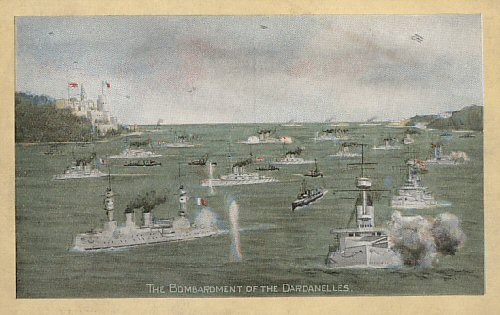

The First and Second Naval Bombardment of the Dardanelles - 19 February 1915

With Winston Churchill having (as First Lord of the Admiralty) succeeded in securing War Cabinet backing for action in the Dardanelles, he lost no time in implementing a blueprint for a purely naval bombardment of the Dardanelles Straits in February 1915.
A purely naval bombardment of the Straits had long been recognised in professional naval circles as a most difficult undertaking. Some eight years earlier, in 1907, a British study had concluded that an attack upon the Straits was feasible only so long as the operation was a combined naval/ground undertaking.
However Churchill, impatient for action, demanded that Sir Sackville Carden - the British naval commander in the Mediterranean - provide him with a proposal for a naval-only offensive upon the Straits.
The Straits - 65km in length and 7km in width aside from 'The Narrows' where the banks were as little as 1,600 apart - were overlooked by steep and heavily fortified cliffs (the Gallipoli peninsula to the northwest and the coast of Asia Minor to the south). Navigation through the wildly varying current was additionally deemed problematic.
Carden's plan was three-fold. He proposed instead that the forts' outer guns should first be neutralised via long-range gunfire, the battleships out of effective range of the fortress guns. This accomplished an Allied fleet would progress further up the Straits (to The Narrows) to enable medium-range artillery to destroy shore batteries while minesweepers wiped out probable minefields blocking their path. The final phase envisaged the destruction of the inner forts.
Success would provide a path to Constantinople, thereby knocking Turkey out of war, and - importantly - open a supply lane to the Sea of Marmora and Britain's ally Russia.
Churchill's plan was formally approved by the War Cabinet at the end of January 1915.
Meanwhile the French government, in the form of incoming naval minister Jean Augagneur, committed four French pre-dreadnoughts to add to the British fleet. He came to an understanding with Churchill that should the expedition give signs of failure the 'demonstration' would be abandoned without loss of prestige.
Churchill set a date of 19 February for the opening of the naval bombardment. The combined British and French fleet consisted of the new battleship Queen Elizabeth, 3 battlecruisers, 16 pre-dreadnought (including four French vessels,) 4 cruisers, 18 destroyers, 6 submarines, 21 trawlers plus the seaplane carrier Ark Royal. Overseeing the effort was Carden.
Pounding the outer fortresses Cape Helles and Kum Kale from long-range on 19 February the British and French attack proved ineffective in the face of an efficient Turkish defensive system and poor Allied gunnery, although greater damage was inflicted than the bombarding naval forces realised. Unbeknown to the Allies the Turkish defenders were also critically short of ammunition.
A renewed bombardment from closer range the following week (following a pause for adverse weather), on 25 February, was similarly unsuccessful. While the outer forts were themselves seized by marines the Allied force could not effective silence the 24 Turkish mobile batteries that poured shellfire from the heights and served as highly effective protection for the elaborate minefield defence set in place in The Narrows.
Without neutralising the minefield the fleet could not move forward: and without destroying the mobile batteries the minefields were adequately protected. While stage one of Carden's plan had therefore been accomplished serious difficulties impeded an advance to the second stage.
Still, the relative lack of progress of the first two naval bombardment attempts did not deter Churchill from ordering Carden to try again, this time via a determined effort to force The Narrows and remove the minefield threat. This duly took place on 18 March 1915 amid heavy failure.
In the meantime plans were afoot in London for the despatch of an expeditionary ground force under Sir Ian Hamilton, thereby fully committing Allied resources to the region.
The following Allied ships took part in the bombardment:
Queen Elizabeth, Vengence, Cornwallis, Triumph, Agamemnon, Inflexible, Albion, Queen, Majestic, Canopus, Prince George, Implacable, Ocean, Irresistable, Euryalus, Dublin, Amethyst, Sapphire.
France: Suffren, Gaulois, Bouvet, Jaure, Guilberry.
Russia: Askold.
Plus many destoyers, mine-sweepers, sea-planes and submarines.